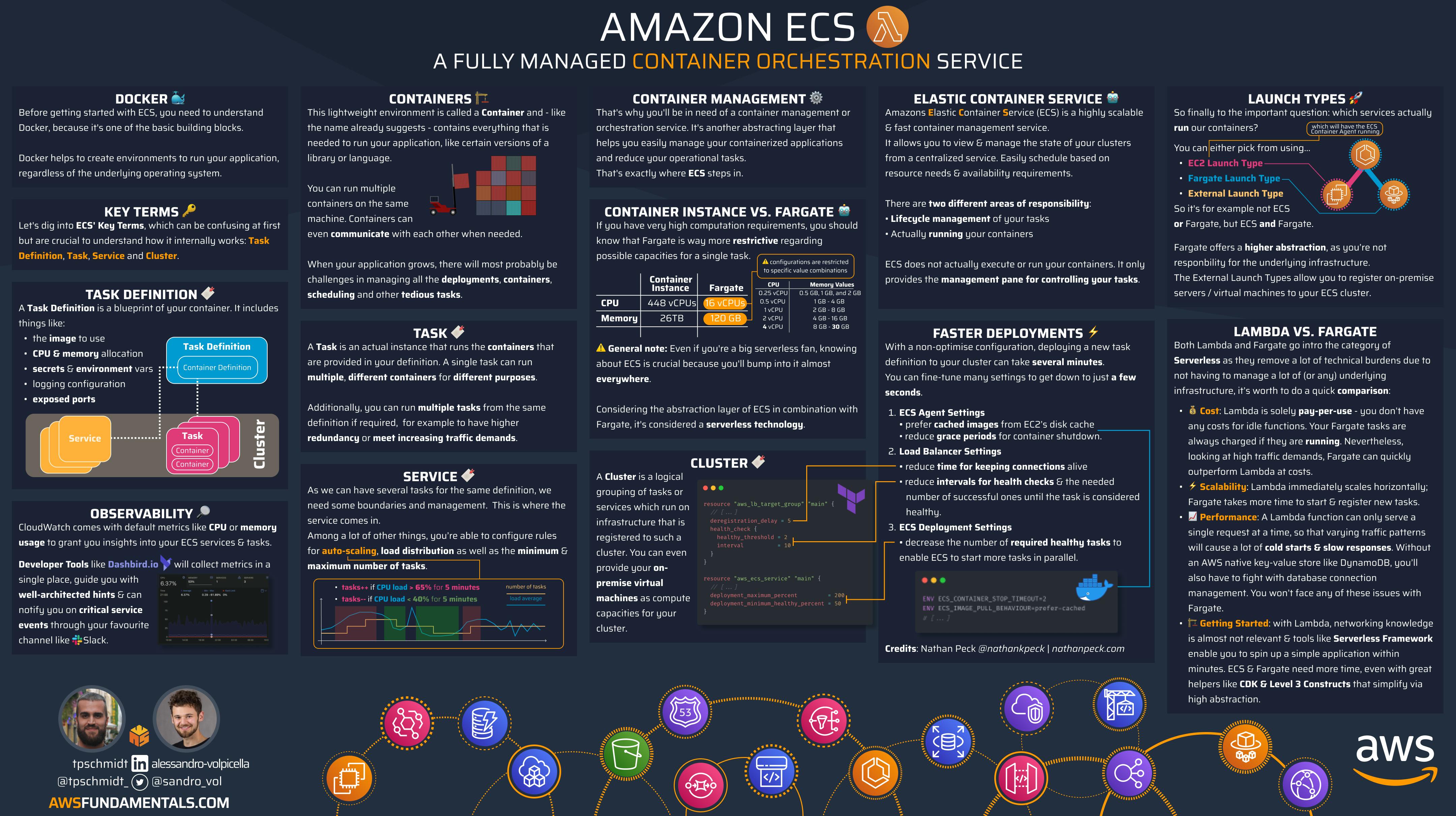The Ultimate Beginner's Guide to AWS ECS
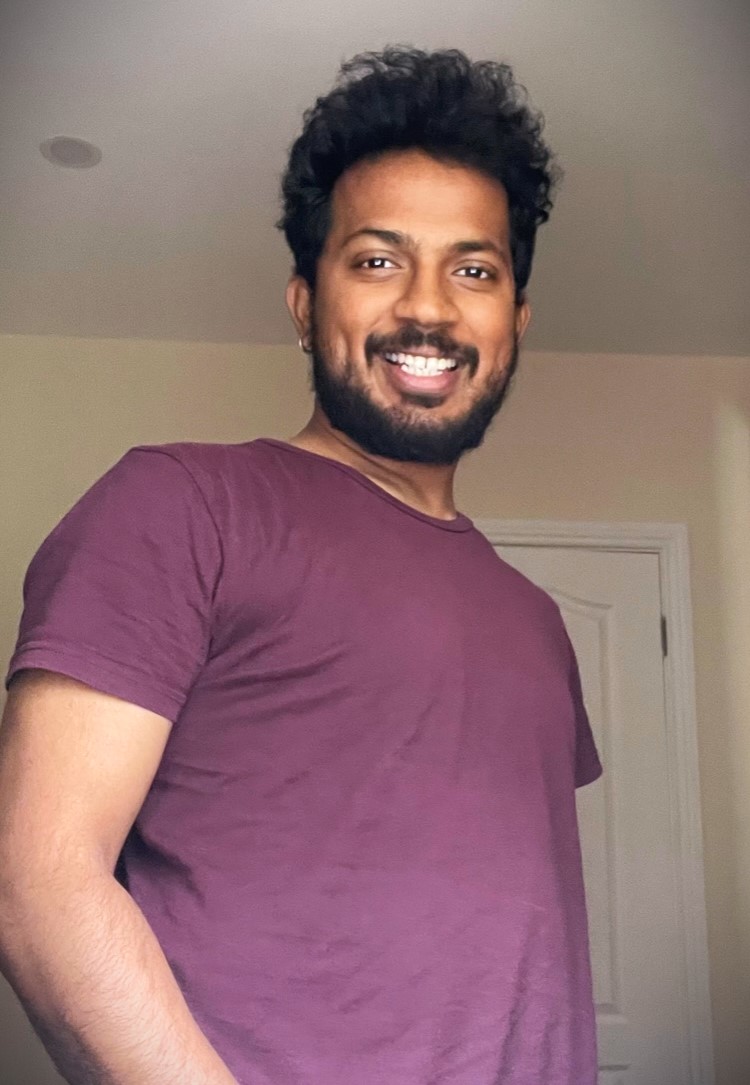 Mayank Sharma
Mayank Sharma
The internet world runs on containers and Amazon Elastic Container Service is one of the most famous and used orchestration panes for them.
Whether you're a seasoned professional or an ECS novice, this comprehensive guide will equip you with the knowledge and skills to deploy and manage containerized applications with confidence.
AWS ECS Infographic
No matter your level of experience, whether you're a seasoned professional, a beginner, or completely unfamiliar with ECS, we invite you to explore our comprehensive infographic. This visually engaging resource provides all the vital details you need to know about Amazon ECS.
Prerequisite Knowledge
Before we jump into details, let's explore the essential foundation, covering topics like containerization, resource management, and every key concept that paves the way for your journey with AWS ECS.
What Are Containers?
Think of containers as magic boxes for software. Each container holds everything a piece of software needs to run smoothly, including the code, libraries, and settings.

These containers are like little worlds of their own, isolated from the outside, where your applications can live happily.
The Old Way vs. Containers
Before containers, deploying software was like building a house from scratch every time you wanted to move. It was slow, error-prone, and required lots of effort. With containers, it's more like moving into a fully furnished room. You can pick it up and place it anywhere; it'll work just the same.
The Container Magic
Containers make this magic happen through a neat trick called "containerization." It's like putting your software in a protective bubble. Inside this bubble, your software has everything it needs to run without any interference from the outside.
How Containers Work
Imagine containers as lunchboxes with layers:
Base Layer (Operating System): This is like the plate at the bottom. It's the foundation that everything sits on.
Application Layer: Your application and its buddies (like libraries) hang out here. This is where the action happens.
Extra Layers: Just like adding toppings on a pizza, you can add extra stuff like configuration files or data.
By breaking things into layers, containers are easier to manage. You can reuse parts of containers, save resources, and keep things tidy.
Why Containers Matter
Containers are superheroes in the software world for a few reasons:
They Keep Things Consistent: With containers, your software behaves the same way no matter where you put it—whether it's on your computer or in the cloud.
They're Safe and Sound: Containers stay isolated, so one container can't mess with another. It's like each container lives in its own little world.
They're Portable: You can easily move containers around. It's like being able to pack up your room and take it with you wherever you go.
They Don't Hog Resources: Containers are light on your computer's memory and CPU, so they don't slow things down.
They Grow and Shrink: You can have more containers when you need them and fewer when you don't. It's like magic!
ECS Fundamentals
Amazon Elastic Container Service (ECS) is a powerful and flexible container orchestration service that Amazon Web Services (AWS) provides. It simplifies containerized applications' deployment, scaling, and management, making it easier for developers to build, package, and run applications in containers. In this chapter, we will explore ECS, its features, and its role in modern cloud computing.
What is ECS?
Amazon ECS is a fully managed container orchestration service that allows you to run, stop, and manage Docker containers on a cluster. It takes care of the underlying infrastructure, including the provisioning and scaling of resources, allowing you to focus on your applications. ECS is designed to work seamlessly with other AWS services, providing a comprehensive container management solution.
Features of ECS
Container Orchestration
ECS simplifies container orchestration by managing the placement of containers across a cluster of EC2 instances or using the serverless AWS Fargate launch type. It ensures that containers are evenly distributed, highly available, and easily scalable.
Deep Integration with AWS
ECS integrates seamlessly with other AWS services, such as Amazon Elastic Load Balancing (ELB), Amazon VPC, AWS Identity and Access Management (IAM), AWS CloudWatch, and more. This tight integration simplifies tasks like load balancing, security, and monitoring.
Flexibility in Launch Types
ECS offers two launch types: ECS on EC2 and AWS Fargate. ECS on EC2 allows you to manage your own EC2 instances to run containers, providing maximum control and flexibility. AWS Fargate, on the other hand, abstracts the underlying infrastructure, making it a serverless option ideal for simplified deployments.
Scalability
ECS can automatically scale your containerized applications based on defined criteria. You can set up auto-scaling policies to handle traffic spikes or changes in demand, ensuring optimal resource utilization.
Service Discovery
ECS provides service discovery mechanisms, making it easy for containers to discover and communicate with each other using DNS or dynamic port mapping. This simplifies building microservices architectures.
Load Balancing
ECS integrates with Elastic Load Balancing (ELB) to distribute incoming traffic across containers. ELB automatically detects healthy containers and directs traffic to them, improving application availability and fault tolerance.
Security
ECS ensures secure container deployments with features like IAM roles for tasks, task execution roles, and network isolation through Amazon VPC. It also supports integration with AWS Secrets Manager for sensitive data management.
Cost Optimization
You pay only for the computing resources and capacity you use with ECS. Its fine-grained resource allocation and cost management options help optimize your containerized application's operational costs.
Launch Types
Launch types define the underlying infrastructure where your containers run within ECS. AWS ECS provides three primary launch types, each with its unique use cases, advantages, and considerations.
ECS with EC2
ECS on EC2 operates as the traditional approach to running containers in a familiar server environment. Here's how it works:
EC2 Instances: You provision and manage EC2 instances, which act as your virtual servers. These instances run the ECS agent to facilitate container management.
Task Placement: With ECS on EC2, you have precise control over where your containers execute. You can specify which EC2 instances should host particular tasks, optimizing resource utilization.
Customization: You can customize your EC2 instances to meet specific requirements, such as installing additional software or configuring network settings.
Use Cases: ECS on EC2 suits applications that demand fine-grained control over the underlying infrastructure. It's well-suited for legacy applications, complex networking setups, or situations where you need to run containers on existing EC2 instances.
Considerations: While ECS on EC2 provides flexibility, it also involves more operational overhead, such as managing EC2 instances and handling updates.
ECS with Fargate
AWS Fargate is the "magic" launch type that abstracts away the infrastructure entirely. It's akin to having a container orchestration service without the need to manage servers:
Serverless Containers: With Fargate, you don't need to worry about provisioning or managing EC2 instances. AWS handles all the infrastructure management for you, allowing you to concentrate solely on your containers.
Resource Isolation: Each task in Fargate operates in its isolated environment, ensuring resource separation and enhancing security.
Scalability: Fargate is highly scalable. It automatically scales your tasks based on your application's requirements, ensuring optimal resource utilization.
Use Cases: AWS Fargate is ideal for scenarios where you want to run containers without dealing with server management. It's excellent for modern, microservices-based applications and when you require rapid scaling.
Considerations: While Fargate provides ease of use, it may not be suitable for applications that require extensive customization or rely on specific EC2 instance types.
For using ECS with Fargate, we wrote a detailed article to get you started with everything you need to know.
External
External is a unique launch type in ECS that allows you to manage containers running outside the ECS ecosystem. With this launch type:
External Resources: You can integrate ECS with external services or resources. This is particularly useful when you have containers running on on-premises servers or other cloud providers.
Hybrid Deployments: External launch type enables hybrid deployments, where some containers run within ECS while others reside externally. This flexibility is valuable in complex architectures.
Use Cases:
Integration with External Services: Employ the External launch type when you have containers that cannot be directly managed by ECS due to specific constraints. It also serves well in orchestrating containers across multiple diverse environments.
Amazon ECS Anywhere: Extend the capabilities of external containers by using the External launch type with Amazon ECS Anywhere. This allows you to run containerized applications on your on-premise servers or virtual machines, registered with your Amazon ECS cluster and managed remotely. Useful for maintaining containerized workloads on your own infrastructure, whether on-premises or in a hybrid environment.
AWS Outposts: Consider using the External launch type for AWS Outposts, a fully managed service that extends AWS infrastructure, AWS services, APIs, and tools to virtually any datacenter, co-location space, or on-premises facility for a truly consistent hybrid experience.
Considerations: While the external launch type provides integration possibilities, it involves additional complexity in managing external resources and ensuring compatibility which could be handled by AWS Outpost the fully manage service.
Choosing the Right Launch Type
Selecting between ECS on EC2, AWS Fargate, and External hinges on your application's demands.
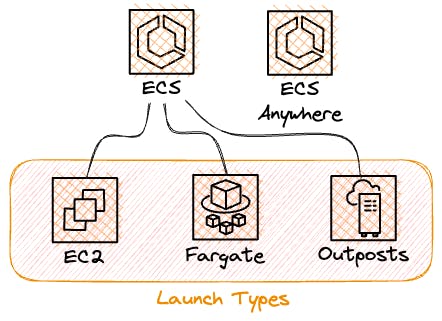
ECS on EC2 offers greater control and customization over your infrastructure. Opt for it when you need precise resource management and compatibility with existing EC2 instances.
AWS Fargate is the choice if you want to focus solely on your containers without concerning yourself with infrastructure management. It's perfect for modern, serverless, and scalable applications.
External is ideal for orchestrating containers running outside the ECS environment. Use it when you need to integrate with external resources or manage hybrid deployments.
Niche Fact: The Power of Mixing
One of the remarkable features of ECS is the ability to combine launch types within the same application. Picture running your frontend on Fargate for effortless scaling, your backend on EC2 instances for fine-tuned control, and integrating with external resources where necessary. This flexibility enables you to harness the best of all worlds.
Remember that AWS ECS allows you to mix and match different launch types within a single cluster. You can choose the most suitable launch type for each component of your application, optimizing resource utilization and simplifying management.
Key Components
We will dive deep into the key components that form the backbone of Amazon Elastic Container Service (ECS).
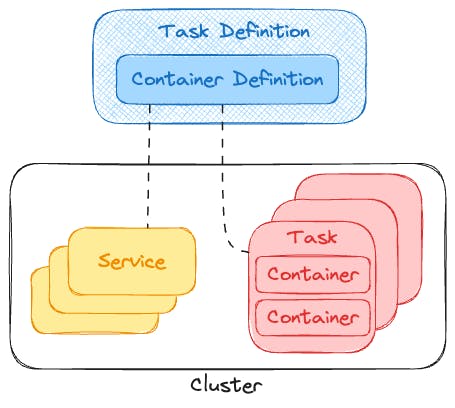
Whether you're just starting your journey with containers or a seasoned AWS explorer, understanding these components is essential for harnessing the full power of ECS.
Namespaces: Logical Isolation
Namespaces provide a powerful way to isolate and organize your containers and resources within a cluster. They offer:
Isolation: Namespaces allow you to create isolated environments within a cluster, providing logical separation for containers and resources.
Resource Organization: Namespaces help organize your containers and tasks by grouping them based on a common purpose, project, or environment.
RBAC (Role-Based Access Control): You can implement Role-Based Access Control within namespaces, controlling who can access and manage resources within each namespace.
Namespaces are beneficial when you need to isolate environments, host multiple tenants on a shared cluster, or segregate workloads with different security requirements.
Use Case: Team A can have its namespace for developing a microservices-based application, and Team B can have another namespace for running data processing tasks. This way, each team can work independently, and their containers won't interfere with each other's work. Namespaces provide a structured and organized approach to managing containerized applications within a shared ECS cluster.
Clusters: Where It All Begins
Clusters are the foundation of ECS. Think of them as isolated environments where your containerized applications live and operate. Here's a closer look:
Logical Separation: Clusters provide logical separation, allowing you to group related containers together. You can create clusters for different purposes like development, testing, or production.
Resource Management: Within each cluster, you manage the underlying compute resources, such as EC2 instances or AWS Fargate tasks. This helps you efficiently utilize resources while maintaining isolation.
Clusters organize your containers, offering resource isolation and management for different workloads and environments.
Use Case: Imagine you're running a web application with a development environment and a production environment. Clusters keep these environments separate, preventing development changes from affecting production.
Task Definitions: Blueprint for Containers
Task Definitions serve as blueprints for your containers. They specify how containers should behave when they run in ECS. Key details include:
Container Configuration: Task Definitions define container images, CPU and memory limits, environment variables, and networking settings.
Multi-Container Tasks: You can create tasks with multiple containers that share resources and network space, allowing you to build complex applications.
Task Definitions ensure consistency in container deployments, simplifying the management of complex applications.
Use Case: Suppose you have a microservices-based application. Task Definitions help define how each service's containers should be configured and deployed.
Services: The Reliable Workforce
Services in ECS define how many copies of a task should run and ensure they maintain their desired state. They provide reliability for your applications:
Scaling Simplicity: You specify the desired number of tasks to run, and ECS handles automatic scaling, adding or removing tasks as needed.
Traffic Management: Services can be associated with Elastic Load Balancers (ELB), ensuring incoming traffic is evenly distributed across tasks.
Services guarantee high availability and the ability to handle varying workloads while maintaining consistency.
Use Case: Consider a web application. ECS Services can manage the web server containers, ensuring there are always enough to handle incoming requests.
Container Instances: The Workhorses
Container Instances serve as the hosts for your containers. They can be either EC2 instances or AWS Fargate tasks. Here's what you should know:
Resource Providers: Container Instances offer the essential computing resources needed to run your containers. Think of them as your containers' home.
ECS Agent: Each Container Instance runs the ECS Agent, a critical software component responsible for task management and resource reporting.
Container Instances abstract the underlying infrastructure, simplifying the deployment and management of your containers.
Use Case: Suppose you have a large-scale application. Container Instances provide the infrastructure needed to deploy and run your containers efficiently.
ECS Agent: The Task Coordinator
The ECS Agent is like a conductor for your container tasks. It resides on Container Instances and takes care of several important tasks:
Task Management: The ECS Agent handles starting, stopping, and monitoring your containers according to the Task Definitions you provide.
Resource Reporting: It sends valuable resource utilization metrics to ECS, helping with intelligent task placement decisions.
The ECS Agent ensures that your containers run correctly and efficiently, making it a crucial part of the ECS ecosystem.
Use Case: In a dynamic environment with frequently changing workloads, the ECS Agent ensures containers are always in the desired state.
Elastic Load Balancing (ELB): The Traffic Cop
Elastic Load Balancing plays a pivotal role in ECS by distributing incoming traffic across multiple tasks, ensuring high availability and load balancing:
Application Load Balancers: ECS can automatically link tasks to Application Load Balancers, ensuring traffic goes to healthy containers.
Network Load Balancers: For tasks with high network demands, Network Load Balancers can be used.
ELB enhances the availability and reliability of your applications by routing traffic to the right places, ensuring scaling and redundancy.
Use Case: In a microservices architecture, ELB ensures that client requests are distributed across all instances of a service for optimal performance and availability.
Niche Insight: Dynamic Port Mapping
ECS offers dynamic port mapping, which allows multiple containers of the same task to run on a single EC2 instance. ECS automatically assigns unique host port numbers, simplifying networking setup and avoiding conflicts.
With these foundational components, you have a solid understanding of ECS's inner workings. These elements work together seamlessly to provide a robust and scalable platform for running containerized applications in the AWS cloud.
Key Benefits
We'll explore the myriad benefits of Amazon Elastic Container Service (ECS), which make it a compelling choice for deploying and managing containerized applications. Whether you're focused on scalability, resource efficiency, integration, cost-effectiveness, or portability, ECS has got you covered.
Scalability: Meet the Demands of Your Workload
ECS offers a range of features that allow your applications to scale seamlessly:
Auto Scaling: ECS can automatically scale the number of tasks up or down based on your application's needs. This ensures that your services are always responsive, even during traffic spikes.
Service Auto Scaling: With Service Auto Scaling, you can define scaling policies based on CloudWatch metrics. ECS will adjust the desired task count according to your predefined rules.
Load Balancer Integration: When used with Elastic Load Balancers (ELB), ECS can distribute incoming traffic across your tasks, effectively balancing the load and preventing overloading.
Use Case: Imagine an e-commerce website that experiences increased traffic during holiday seasons. ECS's scalability ensures that additional instances of your application are automatically spun up to handle the load, ensuring a smooth shopping experience for users.
Resource Optimization: Efficiency at Its Best
Efficiently utilizing computing resources is crucial for both performance and cost-effectiveness:
Task Placement Strategies: ECS allows you to define task placement strategies, such as binpacking and spread, to optimize the distribution of tasks across your cluster's resources.
Fine-Grained Control: You can specify the exact amount of CPU and memory resources each container needs. ECS ensures that resources are allocated as efficiently as possible, reducing waste.
Task Scheduling: ECS uses a task scheduler that places tasks on instances based on your constraints and resource requirements.
Use Case: In a cluster with mixed workloads, resource optimization ensures that tasks with high resource demands are placed on instances with available resources, avoiding resource contention.
Integration with AWS Services: Seamless Ecosystem
ECS is deeply integrated with other AWS services, creating a seamless ecosystem:
CloudWatch Integration: Monitor your ECS resources using Amazon CloudWatch, enabling real-time visibility into your containerized applications' performance and resource utilization.
VPC Networking: ECS leverages Amazon Virtual Private Cloud (VPC) for secure and isolated network communication, giving you control over the network configuration.
IAM Role Integration: ECS tasks can assume IAM roles, allowing you to securely interact with other AWS services, such as S3, RDS, or DynamoDB, without hardcoding credentials.
Use Case: When building data processing pipelines, ECS can seamlessly interact with AWS Glue, Amazon S3, and Amazon Redshift, ensuring data flows efficiently from source to destination.
Cost-Effectiveness: Pay Only for What You Use
ECS follows a pay-as-you-go model, where you're charged only for the compute resources and services you use:
Resource Allocation: By accurately defining resource requirements, ECS avoids over-provisioning, reducing unnecessary costs.
Service Auto Scaling: ECS's automatic scaling ensures you're using the right amount of resources at any given time, preventing both underutilization and overutilization.
Spot Instances: You can leverage Amazon EC2 Spot Instances with ECS to further optimize costs by using spare EC2 capacity at lower prices.
Use Case: For batch processing tasks that can be interrupted, using Spot Instances with ECS can significantly reduce compute costs while meeting processing deadlines.
Portability: Flexibility Across Environments
ECS allows you to run containers consistently across different environments:
DevOps Workflow: Develop your applications on local containers and easily transition them to ECS in production, ensuring consistency from development to deployment.
Multi-Cloud Deployment: ECS provides flexibility if you need to deploy across multiple cloud providers or on-premises, thanks to its compatibility with Docker standards.
Use Case: You develop a new feature using containers on your local machine. ECS's portability ensures that the same containers work seamlessly when deployed in your production ECS cluster.
As you can see, ECS offers a rich set of benefits that cater to different aspects of container management. Whether you're aiming for efficient resource utilization, cost savings, or the ability to seamlessly integrate with other AWS services, ECS empowers you to build and run containerized applications with confidence.
Pricing Models
Amazon Elastic Container Service (ECS) offers flexible pricing models for different use cases and preferences.
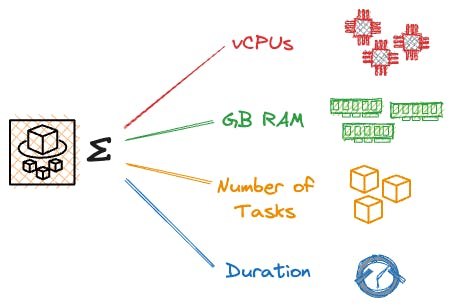
Understanding the pricing options helps you manage your containerized workloads cost-effectively.
Amazon ECS on AWS Fargate
AWS Fargate is a serverless compute engine for containers, providing an efficient and simplified way to manage container workloads. With Fargate pricing, you pay only for the vCPU and memory resources consumed by your tasks. Here's what you should know:
Resource-Based Billing: Fargate pricing is resource-centric, meaning you're billed for the CPU and memory your tasks use rather than the underlying infrastructure. This eliminates the need to manage EC2 instances.
Cost Savings: Fargate abstracts the infrastructure layer, allowing you to focus solely on your containers. It's an excellent choice for applications with dynamic resource requirements, as you pay only for what you consume.
If you want to jump into detail about this, have a read off our in-depth article on ECS pricing.
Amazon ECS on Amazon EC2
When you choose to run Amazon ECS tasks on Amazon EC2 instances, the pricing model is based on EC2's compute capacity. Key points to consider include:
Instance Type: The choice of EC2 instance type significantly influences pricing. Different instance types offer varying CPU, memory, and GPU capabilities, allowing you to select the best fit for your workloads.
Reserved Instances: To save costs, you can opt for Amazon EC2 Reserved Instances, which provide discounted pricing for a one- or three-year commitment. This is an effective cost-optimization strategy for predictable workloads.
Data Transfer Costs: Keep in mind that data transfer costs apply when data moves between AWS regions or leaves the AWS network. Efficiently managing data transfer can lead to significant savings.
Amazon ECS Anywhere
Amazon ECS Anywhere extends the capabilities of ECS to run container workloads on your on-premises infrastructure. While ECS Anywhere itself is a feature of ECS, the pricing considerations are connected to the underlying resources you use, such as your on-premises servers.
On-Premises Infrastructure: ECS Anywhere doesn't introduce additional charges beyond what you incur for your on-premises infrastructure. Your pricing is tied to the hardware and networking resources you manage locally.
Hybrid Deployments: ECS Anywhere allows you to seamlessly manage containerized applications across AWS and your on-premises data centers. You can leverage existing investments while benefiting from AWS cloud capabilities.
Understanding the pricing models in detail for Amazon ECS is essential for optimizing costs and ensuring your containerized workloads align with your budgetary requirements. Depending on your use case, you can choose between AWS Fargate for serverless simplicity, EC2 for fine-grained control, or ECS Anywhere for hybrid deployments. Evaluating your workload's resource needs and usage patterns will help you select the most cost-effective option.
Factors Affecting Pricing
Several factors influence the cost of running containers on ECS:
Instance Type: For EC2-based ECS, the choice of instance type significantly impacts pricing. Different instance types come with varying CPU and memory capacities.
Reserved Instances: If you opt for EC2 instances, you can save costs by using Amazon EC2 Reserved Instances, which provide discounted pricing for a one- or three-year commitment.
Data Transfer Costs: Data transfer costs apply when data moves between AWS regions or leaves the AWS network. Efficiently managing data transfer can lead to significant savings.
Elastic Load Balancing: If you use Elastic Load Balancing (ELB) with ECS, be aware of ELB pricing based on the number of Application Load Balancers or Network Load Balancers you use.
AWS Fargate Resource Consumption: With Fargate, pricing depends on the vCPU and memory allocated to your tasks. Optimizing resource allocation ensures cost efficiency.
Cost Optimization Strategies
Cost optimization is a critical aspect of managing containerized workloads in Amazon Elastic Container Service (ECS). Implementing cost-effective practices can help organizations maximize their resources and minimize unnecessary spending. In this section, we'll explore some strategies for optimizing costs in ECS:
Right-Sizing Container Resources - Analyze your container resource requirements to avoid over-provisioning. ECS allows you to specify CPU and memory limits for each container. Adjust these limits based on your application's actual resource needs.
Utilize Spot Instances - Leverage Amazon EC2 Spot Instances for tasks that can tolerate interruptions. Spot Instances can significantly reduce compute costs compared to On-Demand Instances, making them ideal for fault-tolerant workloads.
Implement Auto Scaling - Configure Auto Scaling for your ECS services to automatically adjust the number of tasks based on demand. This ensures you have the right number of containers running at all times, minimizing idle resources.
Scheduled Scaling - Use scheduled scaling to adjust the desired task count based on anticipated traffic patterns. Scale up during peak hours and scale down during periods of lower demand.
Use Amazon Fargate for Serverless Workloads - Consider AWS Fargate for serverless container execution. With Fargate, you pay only for the vCPU and memory used by your tasks, eliminating the need to manage underlying EC2 instances.
Multi-Stage or Layered Images - Implement multi-stage or layered Docker images to reduce the size of the final image. This minimizes the amount of data transferred and stored, reducing costs associated with image storage and network data transfer.
Elastic Load Balancing (ELB) Optimization - Optimize your use of Elastic Load Balancers. Consider using Application Load Balancers (ALBs) over Classic Load Balancers when possible, as ALBs are more cost-effective and offer advanced routing features.
Reserved Instances (RIs) - Reserve Amazon EC2 instances for long-term workloads with predictable traffic. RIs offer substantial cost savings compared to On-Demand Instances.
Container Instance Rebalancing - Enable container instance rebalancing in your ECS clusters. This feature redistributes tasks evenly among instances, optimizing resource utilization.
Monitoring and Cost Analysis - Regularly monitor your ECS clusters and services to identify cost anomalies. Utilize AWS Cost Explorer and AWS Trusted Advisor to gain insights into your container-related costs.
Resource Tagging - Implement resource tagging to track costs by project, department, or environment. This helps in cost allocation and identifying cost centers.
Review and Optimize Reserved Capacity - Periodically review your EC2 Reserved Instances and make adjustments as your container workloads evolve. Modify or sell unused RIs to align with your current needs.
Cost Control Policies - Implement cost control policies to enforce spending limits and prevent unexpected cost spikes. AWS Budgets and AWS Organizations can assist in cost management.
By applying these cost optimization strategies, organizations can effectively manage their ECS workloads while minimizing unnecessary expenses. Continuously reviewing and adjusting your container resources and infrastructure can lead to substantial cost savings over time.
Security Features
Security is a top priority when it comes to containerized applications. We will explore the robust security features that Amazon Elastic Container Service (ECS) offers to help you safeguard your container workloads on AWS.
Virtual Private Cloud (VPC) Integration
ECS allows you to launch containers within your own Virtual Private Cloud (VPC), providing network isolation and control. This ensures that your containers can communicate securely and avoids exposing them directly to the public internet.
Use Case: Running containers in a VPC is ideal for hosting sensitive applications or services that require restricted network access.
IAM Roles for Tasks
ECS enables you to assign AWS Identity and Access Management (IAM) roles to tasks. This means your containers can securely interact with other AWS services without hardcoding AWS credentials. IAM roles for tasks ensure that only authorized actions are performed.
Use Case: You have an ECS task that needs to write data to an S3 bucket. By attaching an IAM role to the task, you can grant it the necessary permissions to interact with S3 securely.
Task Execution IAM Role
ECS allows you to define a task execution role, separate from the task role. The task execution role is assumed by the ECS service and provides it with permissions to manage tasks on your behalf. This separation enhances security by limiting the permissions of your running tasks.
Use Case: You want to restrict the ECS service's capabilities to start and stop tasks without granting access to sensitive AWS resources.
Security Groups and Network ACLs
You can apply security groups and network access control lists (ACLs) to your ECS tasks and container instances. Security groups act as firewalls at the instance level, while network ACLs provide network-level security. By configuring these, you control inbound and outbound traffic.
Use Case: Implementing security groups and network ACLs ensures that only authorized traffic is allowed to and from your containers, enhancing network security.
Encryption in Transit and at Rest
ECS supports encryption in transit using protocols like TLS/SSL, ensuring secure communication between containers and services. Additionally, data stored in ECS-managed services like Amazon EFS or Amazon RDS can be encrypted at rest for added data protection.
Use Case: When dealing with sensitive data, encrypting communication and storage is essential to prevent data breaches.
Amazon ECR Security
Amazon Elastic Container Registry (ECR), often used with ECS, provides robust security features for container images. These include image scanning for vulnerabilities, encryption of images at rest, and fine-grained access control.
Use Case: Securely storing and distributing container images is crucial for maintaining the integrity of your containerized applications.
By leveraging these security features, you can enhance the protection of your container workloads on ECS.
Use Cases
Amazon Elastic Container Service (ECS) is a versatile and scalable container orchestration platform that finds applications in various industries and use cases.
Digital Transformation with Microservices
Case Study: Netflix
Description: Netflix, a leading streaming service, utilizes ECS to manage its vast microservices architecture. ECS allows Netflix to efficiently deploy and scale microservices, ensuring a seamless streaming experience for millions of users.
E-commerce Scalability
Case Study: Amazon
Description: Amazon, the world's largest e-commerce platform, relies on ECS to handle its dynamic workloads during peak shopping seasons, like Prime Day and Black Friday. ECS enables Amazon to scale resources as needed to meet high customer demand.
Cost-Effective Batch Processing
Case Study: Samsung
Description: Samsung leverages ECS to process large-scale batch jobs for tasks such as image rendering and data analysis. By dynamically allocating resources with ECS, Samsung optimizes costs while ensuring efficient job completion.
Hybrid Cloud Applications
Case Study: Capital One
Description: Capital One uses ECS to manage hybrid cloud applications, seamlessly running containers both on-premises and in the cloud. ECS ensures consistency and scalability across its hybrid infrastructure.
Data Analytics at Scale
Case Study: Expedia
Description: Expedia, a global travel company, employs ECS for running containerized data analytics workloads. ECS helps Expedia process and analyze vast amounts of data, enabling smarter business decisions.
Real-Time Financial Services
Case Study: Robinhood
Description: Robinhood, a financial services company, relies on ECS for its real-time stock trading platform. ECS ensures low-latency, high-availability services, allowing Robinhood to meet the demands of its users.
Game Server Hosting
Case Study: Electronic Arts (EA)
Description: EA, a leading video game company, utilizes ECS to host multiplayer game servers. ECS provides the scalability and reliability required for multiplayer gaming experiences.
IoT Data Processing
Case Study: Philips
Description: Philips employs ECS for processing data generated by healthcare IoT devices. ECS enables Philips to analyze patient data in real-time, improving healthcare outcomes.
Serverless Microservices with Fargate
Case Study: iRobot
Description: iRobot, the maker of the Roomba vacuum, adopts AWS Fargate within ECS to build serverless microservices. Fargate allows iRobot to focus on application logic without managing the underlying infrastructure.
Global Content Delivery
Case Study: Airbnb
Description: Airbnb uses ECS to distribute content globally. ECS facilitates the deployment of containerized content to edge locations, ensuring fast and reliable access for users worldwide.
These real-world case studies demonstrate the versatility and effectiveness of Amazon ECS in a wide range of industries and applications. Whether you're a streaming giant, a financial services provider, or an e-commerce platform, ECS can help you optimize your containerized workloads and accelerate your digital transformation journey.
Wrap Up
In conclusion, AWS ECS is a powerful container orchestration service that simplifies deploying, scaling, and managing containerized applications.
With its robust security features, flexible launch types, and seamless integration with other AWS services, it caters to various use cases and workloads.
By understanding its key components, benefits, pricing models, and cost optimization strategies, you can harness the full potential of ECS to build and run containerized applications with confidence.
Are you interested in more?
Head over to our bi-weekly newsletter or check out the following blog posts:
Frequently Asked Questions
What is the difference between Amazon ECS and Amazon EKS?
Amazon ECS and Amazon EKS (Elastic Kubernetes Service) are both container orchestration services, but they serve different container management needs. ECS is simpler to set up and manage, making it a good choice for users new to container orchestration. EKS, on the other hand, is a managed Kubernetes service and provides more advanced features and flexibility for users who prefer Kubernetes.How do I choose between ECS on EC2 and AWS Fargate?
The choice between ECS on EC2 and AWS Fargate depends on your specific requirements. ECS on EC2 gives you more control over the underlying infrastructure and is suitable for applications with custom networking or specific hardware requirements. AWS Fargate abstracts infrastructure management, making it easier to run containerized workloads without worrying about servers.Can I run Windows containers on Amazon ECS?
Yes, Amazon ECS supports both Linux and Windows containers. You can choose the appropriate task definition launch type to run Windows containers alongside Linux containers in the same ECS cluster.How does ECS handle load balancing?
ECS integrates with Elastic Load Balancing (ELB) services. You can configure an Application Load Balancer or Network Load Balancer to distribute incoming traffic across your ECS tasks. This ensures that traffic is evenly distributed and that your containers can scale horizontally to handle increased loads.How do I secure my containers in ECS?
You can secure your ECS containers by using Amazon VPC for network isolation, IAM roles for tasks to manage permissions, and security groups and network ACLs to control traffic. Additionally, ECS integrates with Amazon ECR for secure container image storage and Amazon EKS for advanced security features when needed.What are the benefits of using ECS over traditional EC2 instances?
ECS offers benefits such as scalability, resource optimization, simplified management, cost-effectiveness, and deep integration with other AWS services. Containers can start and stop quickly, enabling efficient resource usage and faster deployments compared to traditional VMs.Can I run multi-container applications in ECS?
Yes, ECS supports multi-container applications. You can define task definitions with multiple containers that share the same resources, such as CPU and memory. This is useful for deploying sidecar containers, logging agents, or additional application components.How can I optimize ECS costs?
To optimize ECS costs, choose the right instance types, use AWS Fargate for serverless deployments, leverage Amazon EC2 Spot Instances for cost-effective computing, implement auto-scaling based on traffic patterns, and regularly monitor and analyze your ECS costs using AWS Cost Explorer and CloudWatch.Can I use ECS to deploy applications in a hybrid or multi-cloud environment? Yes, ECS provides flexibility and portability for deploying containerized applications. You can run ECS containers on AWS as well as in on-premises environments or other cloud providers, allowing you to adopt a hybrid or multi-cloud strategy while using the same container orchestration service.
Can I run containers in a Virtual Private Cloud (VPC) with Amazon ECS?
Yes, ECS allows you to launch containers within your own Virtual Private Cloud (VPC), providing network isolation and control.
Related Reads
To further enhance your understanding of AWS ECS, consider exploring these articles. They cover topics such as pricing, using ECS with Fargate, and deploying containers:
Subscribe to my newsletter
Read articles from Mayank Sharma directly inside your inbox. Subscribe to the newsletter, and don't miss out.
Written by

Mayank Sharma
Mayank Sharma
👾 Greetings Cyber Enthusiasts! 👾 I am a hacker and offensive security researcher, on a perpetual mission to explore the uncharted realms of cybersecurity. With a focus on offensive security and cloud security red teaming, my passion lies in the relentless pursuit of vulnerabilities within the intricate web of cloud infrastructure. 🌐 Navigating the Digital Battlefield: 🌐 My expertise extends to the art of red teaming, where I meticulously probe and challenge the defenses of digital landscapes. Armed with a profound understanding of offensive security, I am dedicated to unraveling the vulnerabilities that lurk within the cloud itself. 🚀 Let the exploration begin! 🚀
